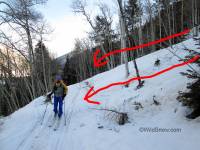
During extreme avalanche danger the lower portion of this Colorado hut approach trail is crossed by quite a few avalanches. They might take you into dense trees or a terrain trap.
We have a lot of avalanche safety tip “listicles” and essays here at WildSnow. To get everyone thinking as well as applying basic consideration in the backcountry, I pulled the following short list out of those posts. We’ve had a couple of exceptional winters here in Colorado in terms of avalanche accidents. Experts debate the reasons for that, instinct tells me it’s a result of many factors: snowpack, luck, etc., but I’m of the opinion that educated skiers adhering to protocols have enhanced the odds in their favor. As in the triad of suggestions below. Discuss? What’s your most common success, or failure?
1. Any one vote against a decision or route changes the group plan — groups always stay together.
2. If you descend first, your odds are worse. Take turns with the firsts, carefully arrange group for observation and quick response. (“I was eating my sandwich and eventually noticed “Bill” wasn’t around…”)
3. Obsess on consequences. A steep run that strainers thorough trees is near certain life changing injury or worse. A lower angled, shorter run without terrain obstacles can be a world of different. If you sport a balloon backpack, this rule is especially important as the airbag, other than perhaps violently bouncing you off a few tree trunks before it shreds, won’t help you one tiny bit during a 60 mph head first ride through a spruce forest. Those same trees are laughing at your “helmet.” Likewise, constant awareness of terrain traps (both small and large) is key.
For more, see our post relating Bruce Tremper’s 10 Commandments of Avalanche Safety.
Also see our extensive avalanche safety coverage.
WildSnow.com publisher emeritus and founder Lou (Louis Dawson) has a 50+ years career in climbing, backcountry skiing and ski mountaineering. He was the first person in history to ski down all 54 Colorado 14,000-foot peaks, has authored numerous books about about backcountry skiing, and has skied from the summit of Denali in Alaska, North America’s highest mountain.
